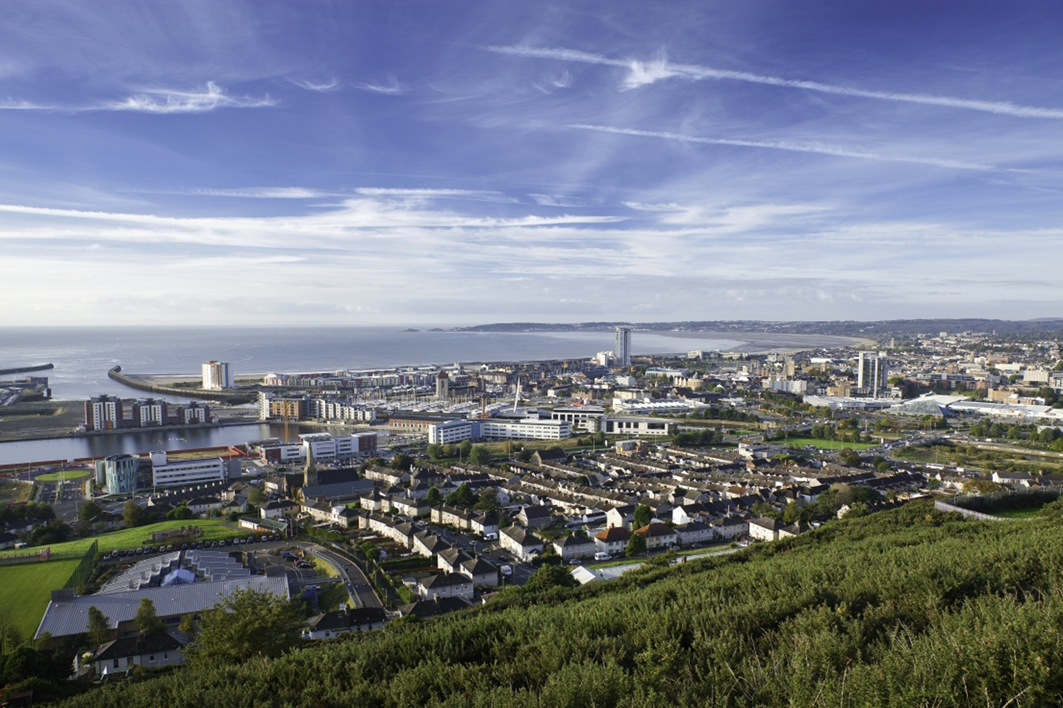
Swansea
Swansea (/ˈswɒnzi/; Welsh: Abertawe [abɛrˈtawɛ]) is a coastal city and the second-largest city of Wales. It forms a principal area, officially known as the City and County of Swansea (Welsh: Dinas a Sir Abertawe).[2]
For other places with the same name, see Swansea (disambiguation).
Swansea
Abertawe (Welsh)City and County of Swansea
Dinas a Sir Abertawe
Dinas a Sir Abertawe
Swansea
1158–1184
1969
Robert Stewart (Lab)
- Gower: Tonia Antoniazzi (Lab)
- Swansea East: Carolyn Harris (Lab)
- Swansea West: Geraint Davies (Lab)
- Rebecca Evans (Lab)
- Mike Hedges (Lab)
- Julie James (Lab)
150 sq mi (380 km2)
- Unitary Authority area: 237,834 Ranked 2nd
- Urban area within Unitary Authority: 179,485
- Wider Urban Area: 300,352
- Metropolitan Area: 462,000
- Swansea Bay City Region: 685,051
1,560/sq mi (601/km2)
- 97.8% White
- 1.5% Asian
- 0.3% Afro-Caribbean
CP, CR, CS, CT, CU, CV
UKL18
The city is the twenty-fifth largest in the United Kingdom. Located along Swansea Bay in southwest Wales, with the principal area covering the Gower Peninsula, it is part of the Swansea Bay region and part of the historic county of Glamorgan and the ancient Welsh commote of Gŵyr.[3]
The principal area is the second most populous local authority area in Wales, with an estimated population of 246,563 in 2020.[4] Swansea, along with Neath and Port Talbot, forms the Swansea Urban Area, with a population of 300,352 in 2011. It is also part of the Swansea Bay City Region.
During the 19th-century industrial heyday, Swansea was the key centre of the copper-smelting industry, earning the nickname Copperopolis.[5][6]
Etymologies[edit]
The Welsh name, Abertawe, translates as "mouth/estuary of the Tawe", and this name was likely used for the area before a settlement was established. The first written record of the Welsh name for the town itself dates from 1150 and appears in the form Aper Tyui.[7]
The name Swansea, pronounced /ˈswɒnzi/ (Swans-ee, not
Swan-sea), is derived from the Old Norse name of the original Viking trading post that was founded by King Sweyn Forkbeard (c. 960–1014).[8][9][10] It was the name of the king, 'Svein' or 'Sweyn', with the suffix of '-ey' ("island"), referring either to a bank of the river at its mouth or to an area of raised ground in marshland.[11] However, the Norse termination -ey can mean "inlet", and the name may simply refer to the mouth of the river.[12]
Public order[edit]
There was a high rate of car crime during the 1990s. In 2002, the BBC described Swansea as a "black spot for car crime".[107] Car crime is a central theme in the film Twin Town, which was set in and around Swansea and Port Talbot.
The football violence that Swansea experienced during the 1970s–1990s has considerably reduced, the only major clashes occurring between Swansea City supporters and Cardiff City supporters. Many matches between these sides have ended in violence in both Swansea and Cardiff. These two clubs have a long history of intense rivalry,[108] so much so that it is described in the media as tribal.